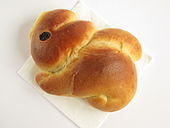Picture bread

Gebildbrot even malleable bread , of meaning or images pastry is a bread or pastry in the form of figurative representations, such as human, rabbit, bird and other, or artful Teigflechtungen. These are pastries that are made and consumed in certain shapes for festivals of the church or the peasant year.
Gebildbrot is given away and eaten on the days that are related to the symbolized or the calendar occasion.
history
These are pastries that are freely shaped (formed) by hand on certain occasions - mostly from yeast dough - and not made in a model or in a baking pan.
The German historian and folklorist Ernst Ludwig Rochholz (1809-1892) coined the term Gebildbrot. In early forms of funeral feasts, spiced biscuits were eaten at funerals to ward off evil spirits.
The Dictionary of German Folklore, published in 1974, is already critical of such opinions of the “popular mythologists of the 19th century”, even though it gives a detailed account of them. Rather, one should reckon with the manufacturer's “personal drive to create sculptures and with baker's moods” or the requirements of the baking process (perforation, splitting). Most common pastries are made from yeast dough, which has been traceable since the 15th century. Around 1700 there were yeast cultivations, but they were primarily aimed at the needs of beer brewers and schnapps distillers and were not very suitable for bakers. It was not until the 19th century that new brewery technologies made sufficient baker's yeast available. From this alone, the pre-Christian cultic theories lead ad absurdum.
Ernst Burgstaller (1906–2000) listed the following items for the Austrian Folklore Atlas:
- Lent : Lenten pretzel, palm pretzel - the term pretzel (from Latin bracellum) is intended to remind of the monastic prayer position of crossed arms
- Easter : Osterfleck, Osterstriezel, Easter croissant, Easter pretzel, Easter Christmas bread
- All Souls' Day : All Souls' Striezel, All Souls' Plot, Soul
- Christmas : Kletzenbrot
- Other pastries in the form of deer (for All Souls' Day, Nicholas, Christmas, Easter and Whitsun), roosters and hens.
The Karawai is the traditional bread that the traditional harvest festival in Belarus after the women have cut with a sickle, the first crop stalks will come.
The artist Hermann Josef Hack uses Gebildbrote in his so-called Weckman demos of the Brote Army Fraction by staging the Weckmann figures with socio-political messages.
Well-known picture breads


- Pretzel in many designs
- Plait (e.g. as yeast plait)
- Couque de Dinant: Gingerbread biscuits from Belgium, forerunner of the Aachen Printen
- gingerbreadhearts
- Christmas tree decorations: angels, stars, moon and the like made from gingerbread dough or salt dough
- Dresden Christmas stollen
- Frankfurter Stutzweck
- Kenkentjüch , sculptured pastries on the North Frisian Jöölboom
- New Year's cookies , ( Neujahrsbopp )
- Agatha bread or agatha rolls for the feast of St. Agatha on February 5th
- Easter breads
- Easter lamb with victory flag
- Reutlinger Mutschel
- called the yeast dough figure, Stutenkerl, Weckmann, Klausenmann or Grättimaa; also as Johannismandl on the feast of the birth of St. John the Baptist common
- Sugar men; Honey cake batter from Saxony
- Colorful bread from Fehmarn
- Ascension birds on Ascension Day
- Schöderer birds (in memory of the return of birds after the plague) are baked on May 1st in Schöder (Styria)
- Reformation rolls
- the Czech or Polish Kolatsche , which was given as a present to the bride and groom at the wedding
literature
- Inge Carius: Gebildbrot. Customs in the year and curriculum vitae. Langewiesche, Königstein 1986, ISBN 3-7845-6260-4 .
- Hans Jürgen Hansen (Hrsg.): Art history of baking. History and development of the types of biscuits and their shapes . Stalling Verlag, Hamburg / Oldenburg 1968, pp. 31–42.
- Max Höfler: Easter biscuits. A comparative study of the Gebildbrote at Easter time (magazine for Austrian folklore. Supplement-Heft IV for the 12th year 1906). Publishing house of the Association for Austrian Folklore, Vienna 1906.
Web links
- Entry on Gebildbrot in the Austria Forum (in the ABC on Austrian Folklore)
Individual evidence
- ^ IREKS Arkady Institute for Bakery Science (ed.): IREKS ABC of the bakery. 4th edition. Institute for Bakery Science, Kulmbach 1985.
- ↑ Manfred Heim : From indulgence to celibacy: Small encyclopedia of church history. Munich 2008, p. 265.
- ^ Beitl: Dictionary of German Folklore . Stuttgart 1974, p. 259; Catalog of the Swiss Museum of Bread and Bread , Lucerne, no year (term comes from Rochholz) p. 6.


